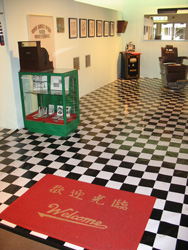Born 1973 in Los Angeles, California; lives in Los Angeles, California
In his installations and community-based projects, Mario Ybarra Jr. reimagines the possibilities of “contemporary art that is filtered through a Mexican-American experience in Los Angeles,” as he told the LA Times. While refusing to discount social or political context, Ybarra remains skeptical about the concept of Chicano identity, a position owing as much to the politicized dockworkers of his native Wilmington neighborhood as to such artists as Rubén Ortiz-Torres and Daniel Joseph Martinez. Indeed, the work of this “cholo aestheticist and inveterate jester,” in the words of critic Andrew Berardini, frequently considers the exigencies—and perverse oddities—of cultural translations and the appropriative acts they presuppose. Brown and Proud (2006) melds Diego Rivera’s civic frescoes with inner-city graffiti art, juxtaposing the Mexican revolutionary Emiliano Zapata with Star Wars character Chewbacca in a large-scale mural emblazoned with slogans (“POR VIDA”/ “FOR LIFE”), frenetic tags, and the requisite badass, bikiniclad model.
At the Serpentine Gallery in London’s Kensington Gardens, Ybarra and his partner, Karla Diaz, created a makeshift ornithological club for The Peacock Doesn’t See Its Own Ass/Let’s Twitch Again: Operation Bird Watching in London (2006). Stuffed birds, found objects, museum artifacts, and corporate designs constituted a sort of anthropological excursion into local “birdlife” on the model of Marcel Broodthaers’s ersatz Musée d’Art Moderne, Département des Aigles (1968). For the 2008 Whitney Biennial, Ybarra realizes The Scarface Museum (2008), exhibiting memorabilia related to the movie from the collection of his friend Angel Montes Jr. The Scarface Museum is an outgrowth of a 2005 performance entitled For All I Know He Had My Friend Angel Killed, in which the artist read from a particularly brutal scene in the screenplay. An homage to Ybarra’s friend, to whom Al Pacino’s character represented a model of success, both works reflect on the story of the fictional gangster–drug dealer as one (admittedly flawed) embodiment of the American Dream.
Ybarra’s art is perhaps most notable for combining critical and institutional recognition with its deep-rooted connection to the social spaces to which it so often refers. The workshop-collective Slanguage (2002–05) and DSN: Do Something New (2007), a project for which local teenagers collaborated in producing T-shirts and other artwork and in recording auxiliary members’ oral histories, demonstrate Ybarra’s commitments. In 2005 Ybarra and Diaz won a competition held by artist Annie Shaw enabling them to convert a barbershop-cumproject space into a small art gallery. Their New Chinatown Barbershop was reproduced at scale for exhibition at Fair Exchange at the 2006 Los Angeles County Fair and the following year at the Tate Modern in London, where it returned to its roots, as it were, as the stage for a haircutting competition. SUZANNE HUDSON
Mario Ybarra Jr., The New Chinatown Barbershop, 2006 (installation view, Los Angeles County Fair, 2006). Mixed media, dimensions variable. Collection of the artist

























